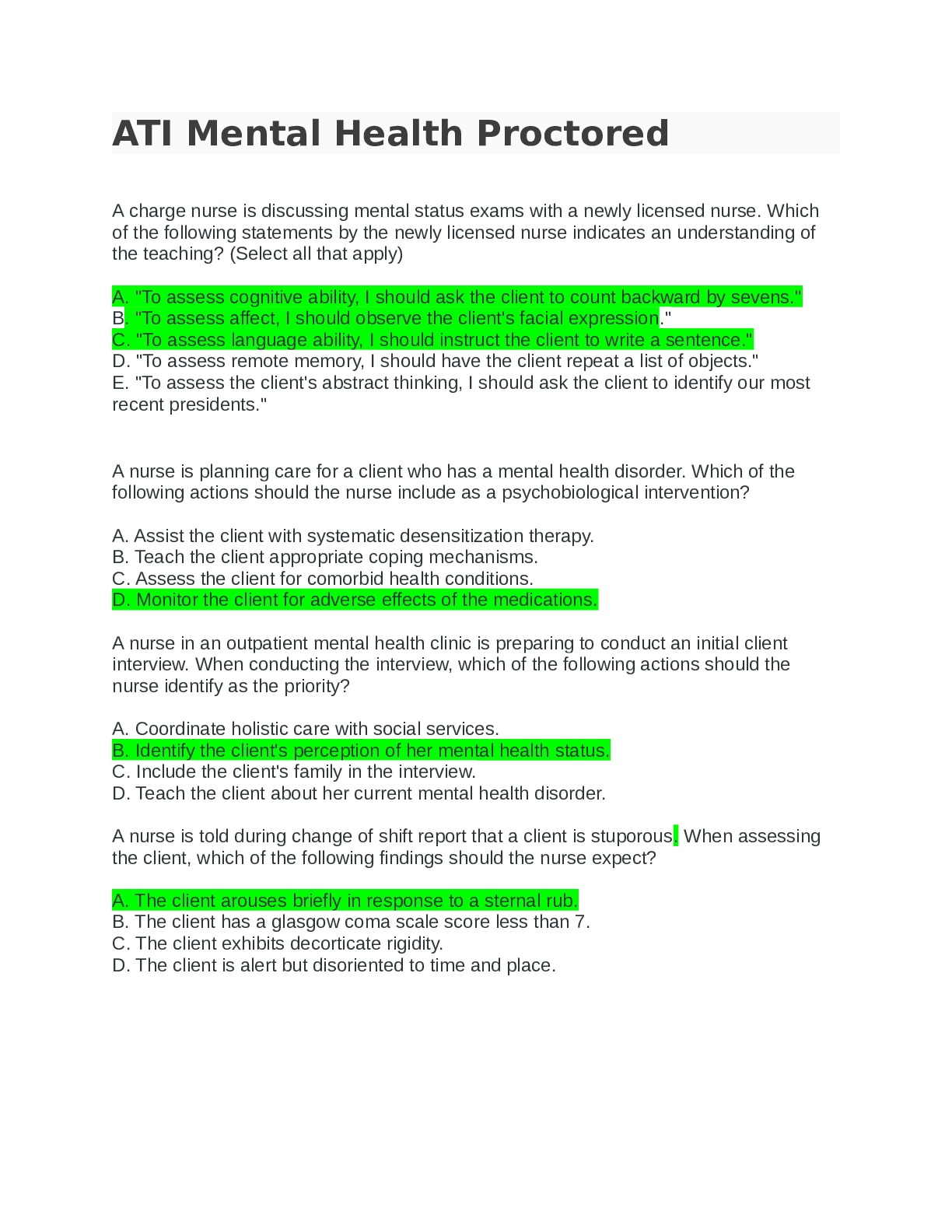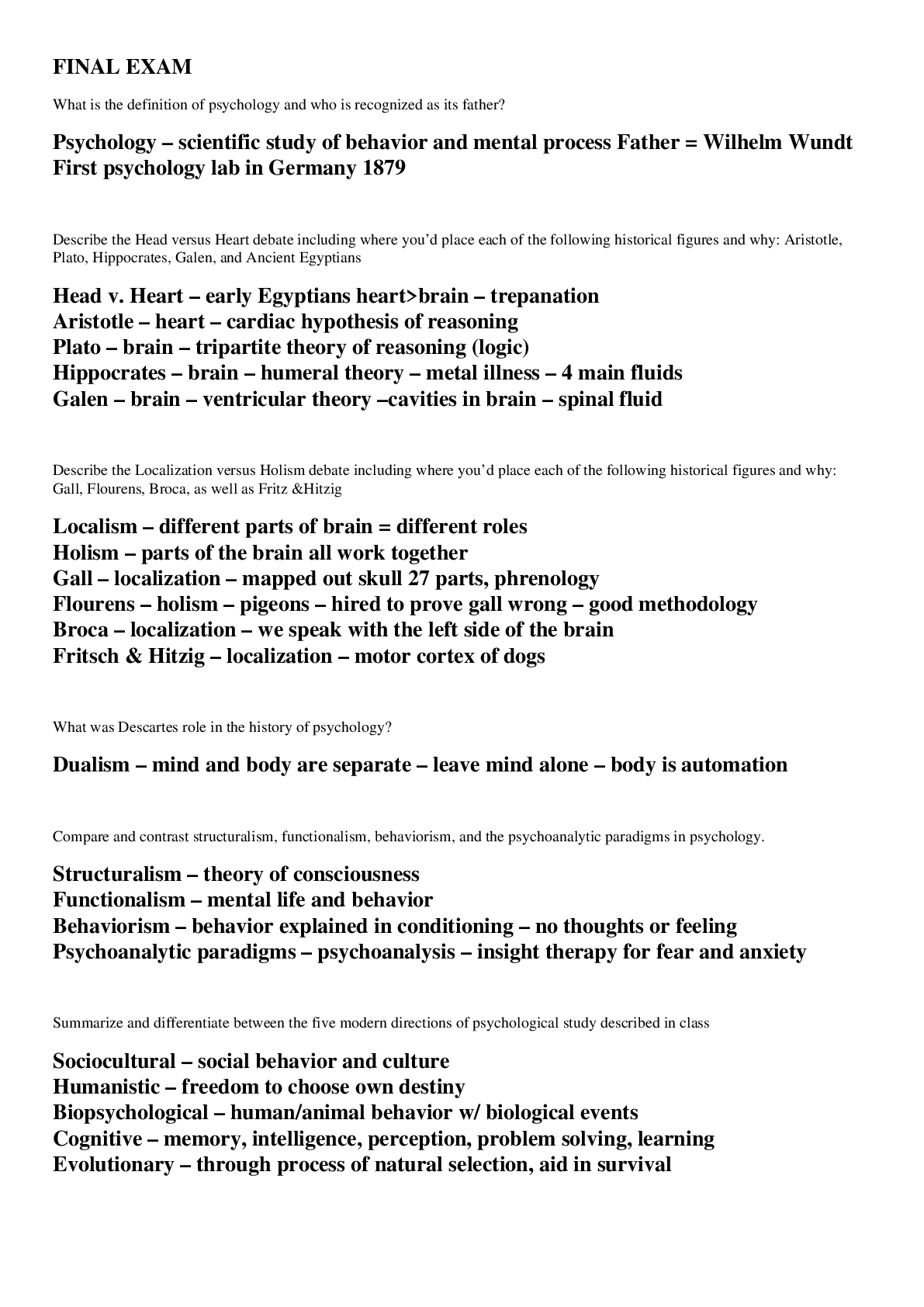*NURSING > QUESTIONS & ANSWERS > National Registry of Emergency Medical Technicians: Emergency Medical Responder Test Bank; fall 2022 (All)
National Registry of Emergency Medical Technicians: Emergency Medical Responder Test Bank; fall 2022 class 500+ Questions With 100% Answers with rationale. Graded A+
Document Content and Description Below
National Registry of Emergency Medical Technicians: Emergency Medical Responder Test Bank; fall 2022 class 500+ Questions With 100% Answers with rationale. Graded A+ Hypoglycemia and acute ischemic... stroke can present similarly because: • A:both oxygen and glucose are needed for brain function. • B:the majority of stroke patients have a history of diabetes. • C:the most common cause of a stroke is hypoglycemia. • D:they are both caused by low levels of glucose in the blood. - ANS- • A:both oxygen and glucose are needed for brain function. Reason: Although stroke and hypoglycemia are two distinctly different conditions, their signs and symptoms are often similar. This is because the brain requires both oxygen and glucose to function normally. An acute ischemic stroke is caused by a lack of oxygen to a part of the brain due to a blocked cerebral artery, whereas hypoglycemia (low blood glucose level) deprives the entire brain of glucose. In either case, the patient presents with signs of impaired brain function (ie, slurred speech, weakness, altered mental status). Both conditions may lead to permanent brain damage or death if not treated promptly. When dealing with an emotionally disturbed patient, you should be MOST concerned with: • A:gathering all of the patient's medications. • B:safely transporting to the hospital. • C:whether the patient could harm you. • D:obtaining a complete medical history. - ANS- You selected C; This is correct! Reason: When managing any patient with an emotional or psychiatric crisis, your primary concern is your own safety. Safely transporting the patient to the hospital is your ultimate goal. If possible, you should attempt to obtain a medical history and should take any of the patient's prescribed medications to the hospital. However, this should not supercede your own safety or interfere with safely transporting the patient.You are at the scene where a man panicked while swimming in a small lake. Your initial attempt to rescue him should include: • A:rowing a small raft to the victim. • B:reaching for the victim with a long stick. • C:throwing a rope to the victim. • D:swimming to the victim to rescue him. - ANS- You selected B; This is correct! Reason: General rules to follow when attempting to rescue a patient from the water include "reach, throw, row, and then go." In this case, you should attempt to reach the victim by having him grab hold of a large stick or similar object. If this is unsuccessful, throw the victim a rope or flotation device (if available). If these are not available, row to the patient in a small raft (if available). Going into the water to retrieve the victim is a last resort. The rescuer must be a strong swimmer because patients who are in danger of drowning are in a state of blind panic and will make every attempt to keep themselves afloat, even if it means forcing the rescuer underwater. How should you classify a patient's nature of illness if he or she has a low blood glucose level, bizarre behavior, and shallow breathing? • A:Behavioral emergency • B:Altered mental status • C:Respiratory emergency • D:Cardiac compromise - ANS- The correct answer is B; Reason: The nature of illness (NOI) is the medical equivalent to mechanism of injury (MOI). Altered mental status should be the suspected NOI in any patient with any fluctuation in level of consciousness, which can range from bizarre behavior to complete unresponsiveness. Causes of an altered mental status include hypo- or hyperglycemia, head trauma, stroke, behavioral crises, drug overdose, and shock, among others. A young female is unresponsive after overdosing on an unknown type of drug. Her respirations are slow and shallow and her pulse is slow and weak. Which of the following drugs is the LEAST likely cause of her condition? • A:Seconal • B:Heroin • C:Cocaine• D:Valium - ANS- The correct answer is C; Reason: Of the drugs listed, cocaine would be the least likely cause of the patient's condition. Cocaine is a central nervous system (CNS) stimulant; you would expect her to be hypertensive, tachycardic, tachypneic, and perhaps even violent. Heroin, Valium, and Seconal are all CNS depressants and could explain her condition. Heroin is an illegal narcotic (opiate), Valium is a benzodiazepine sedative-hypnotic drug, and Seconal is a barbiturate. Narcotics, benzodiazepines, and barbiturates are all CNS depressants. When taken in excess, they cause a decreased level of consciousness, respiratory depression, bradycardia, and hypotension. Activated charcoal is contraindicated for a patient who is: • A:conscious and alert and has ingested a large amount of Motrin. • B:emotionally upset and has ingested two bottles of aspirin. • C:agitated and claims to have ingested a bottle of Tylenol. • D:awake and alert and has swallowed a commercial drain cleaner. - ANS- You selected D; This is correct! Reason:Activated charcoal adsorbs (sticks to) many ingested substances, preventing them from being absorbed into the body by the stomach or intestines. In some cases, you may give activated charcoal to patients who have ingested certain substances, if approved by medical control or local protocol. Activated charcoal is contraindicated for patients who have ingested an acid or alkali (ie, drain cleaner) or a petroleum product (ie, gasoline), who have a decreased level of consciousness and cannot protect their own airway, or who are unable to swallow. The MOST obvious way to reduce heat loss from radiation and convection is to: • A:move away from a cold object. • B:increase metabolism by shivering. • C:wear a thick wind-proof jacket. • D:move to a warmer environment. - ANS- you selected D; This is correct! Reason:In a cold environment, the body has two ways of staying warm: generating heat (thermogenesis) and reducing heat loss. Radiation is the transfer of heat by radiant energy. The body can lose heat by radiation, such as when a person stands in a cold room. Convection occurs when heat is transferred to circulating air, as when cool air moves across the body's surface. Aperson standing in windy cold weather, wearing lightweight clothing, is losing heat to the environment mostly by convection. The quickest and most obvious way to decrease heat loss from radiation and convection is to move out of the cold environment and seek shelter from wind. Shivering increases the body's metabolism and is a mechanism for generating heat, not reducing heat loss. Layers of clothing trap air and provide excellent insulation; thus, layered clothing decreases heat loss better than a single, thick jacket. Conduction is the direct transfer of heat from a part of the body to a colder object by direct contact, as when a warm hand touches cold metal or ice. The most obvious way to decrease heat loss by conduction is to remove your hand from the cold object. A near-drowning is MOST accurately defined as: • A:complications within 24 hours following submersion in water. • B:immediate death due to prolonged submersion in water. • C:survival for at least 24 hours following submersion in water. • D:death greater than 24 hours following submersion in water. - ANS- You selected C; This is correct! Reason:Collectively, drowning and near-drowning are referred to as submersion injuries. Drowning is defined as death after submersion in a liquid medium, usually water. In a drowning, death is either immediate or occurs within 24 hours following submersion. Near-drowning is defined as survival, at least temporarily (24 hours), after submersion. It should be noted, however, that complications such as pneumonia and pulmonary edema can cause death greater than 24 hours following submersion. For this reason, all patients with a submersion injury should be transported to the hospital, even if they appear fine at the scene. A young woman reports significant weight loss over the last month, persistent fever, and night sweats. When you assess her, you note the presence of dark purple lesions covering her trunk and upper extremities. You should suspect: • A:end-stage cancer. • B:HIV/AIDS. • C:tuberculosis. • D:rheumatic fever. - ANS- You selected B; This is correct!Reason:Weight loss, fever, and nig [Show More]
Last updated: 1 year ago
Preview 1 out of 223 pages
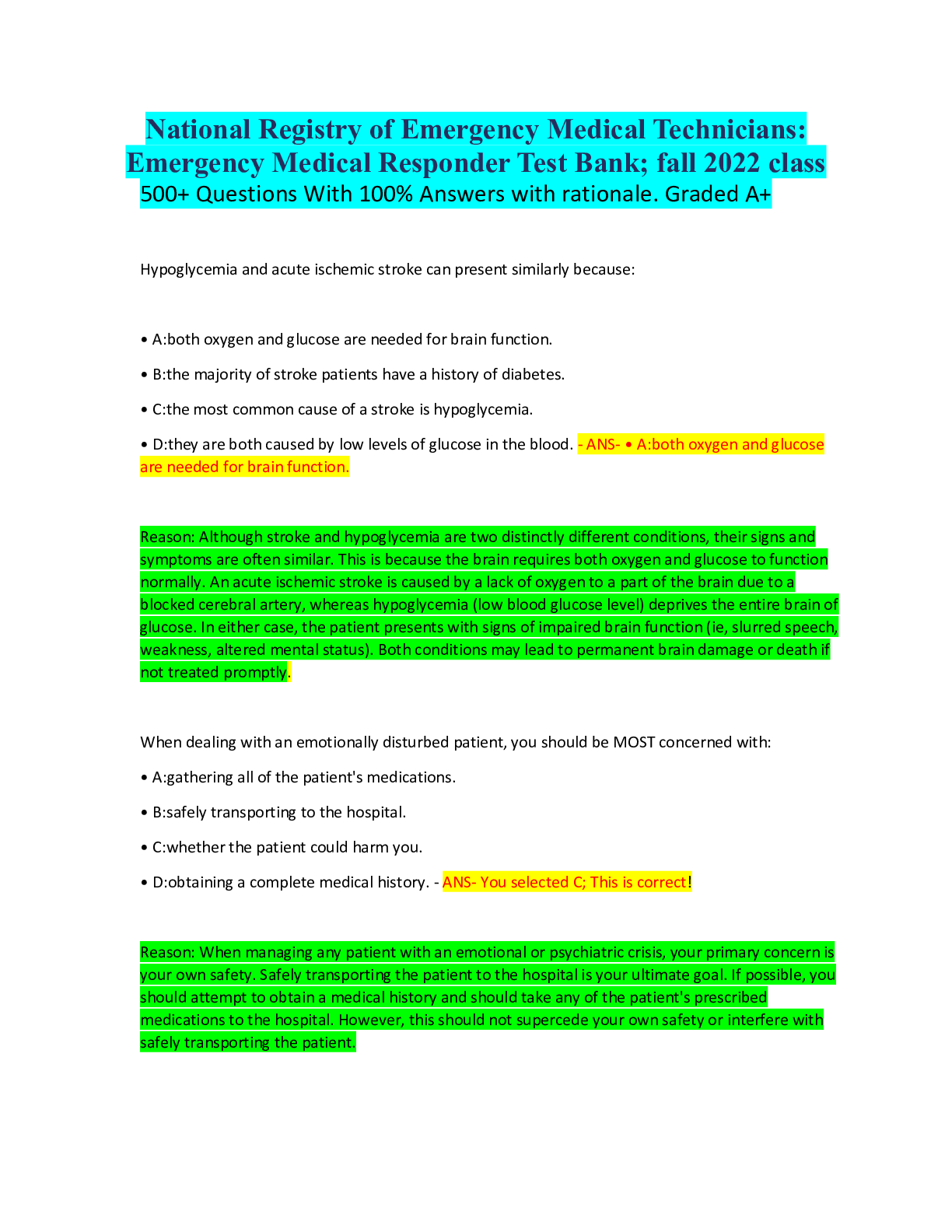
Reviews( 0 )
Document information
Connected school, study & course
About the document
Uploaded On
May 30, 2022
Number of pages
223
Written in
Additional information
This document has been written for:
Uploaded
May 30, 2022
Downloads
0
Views
230


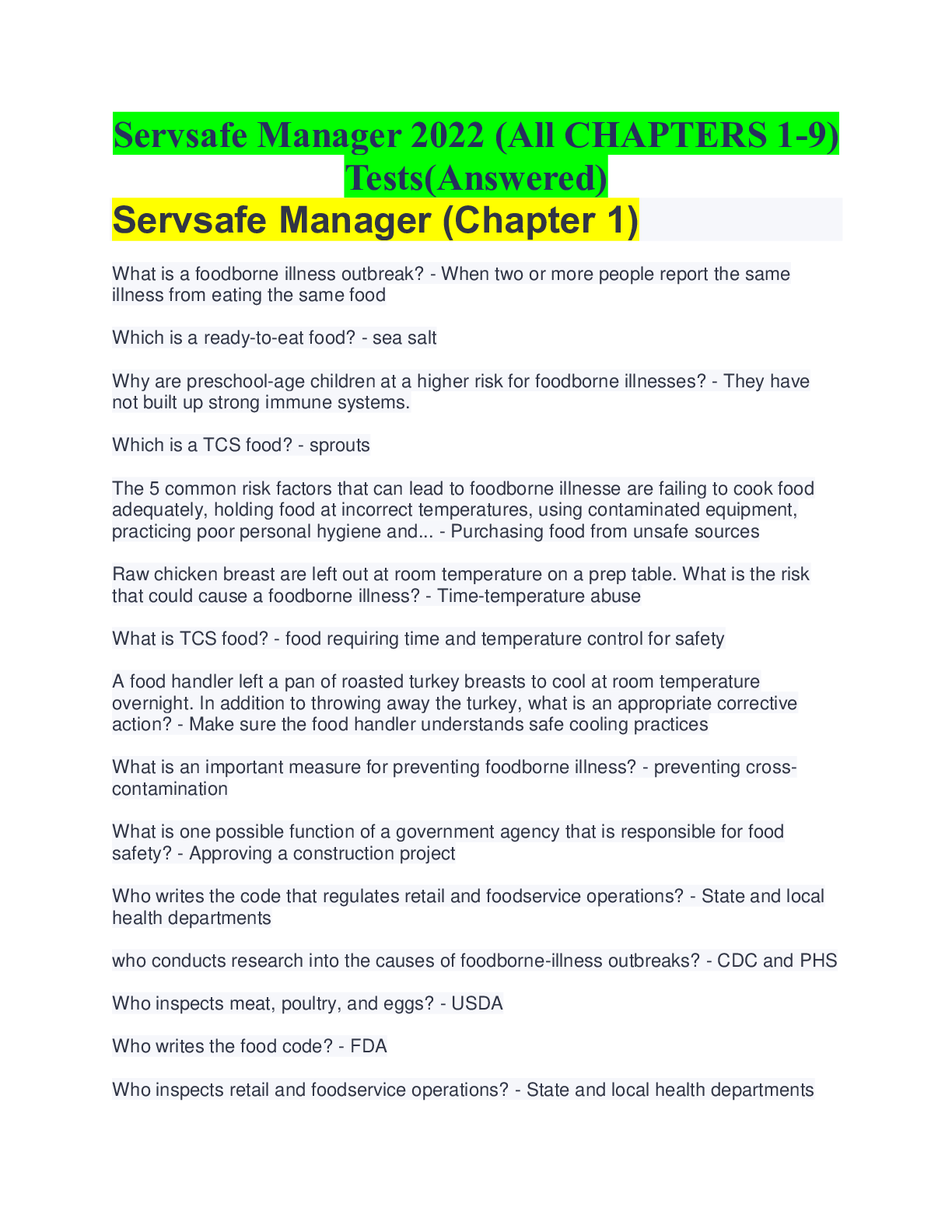
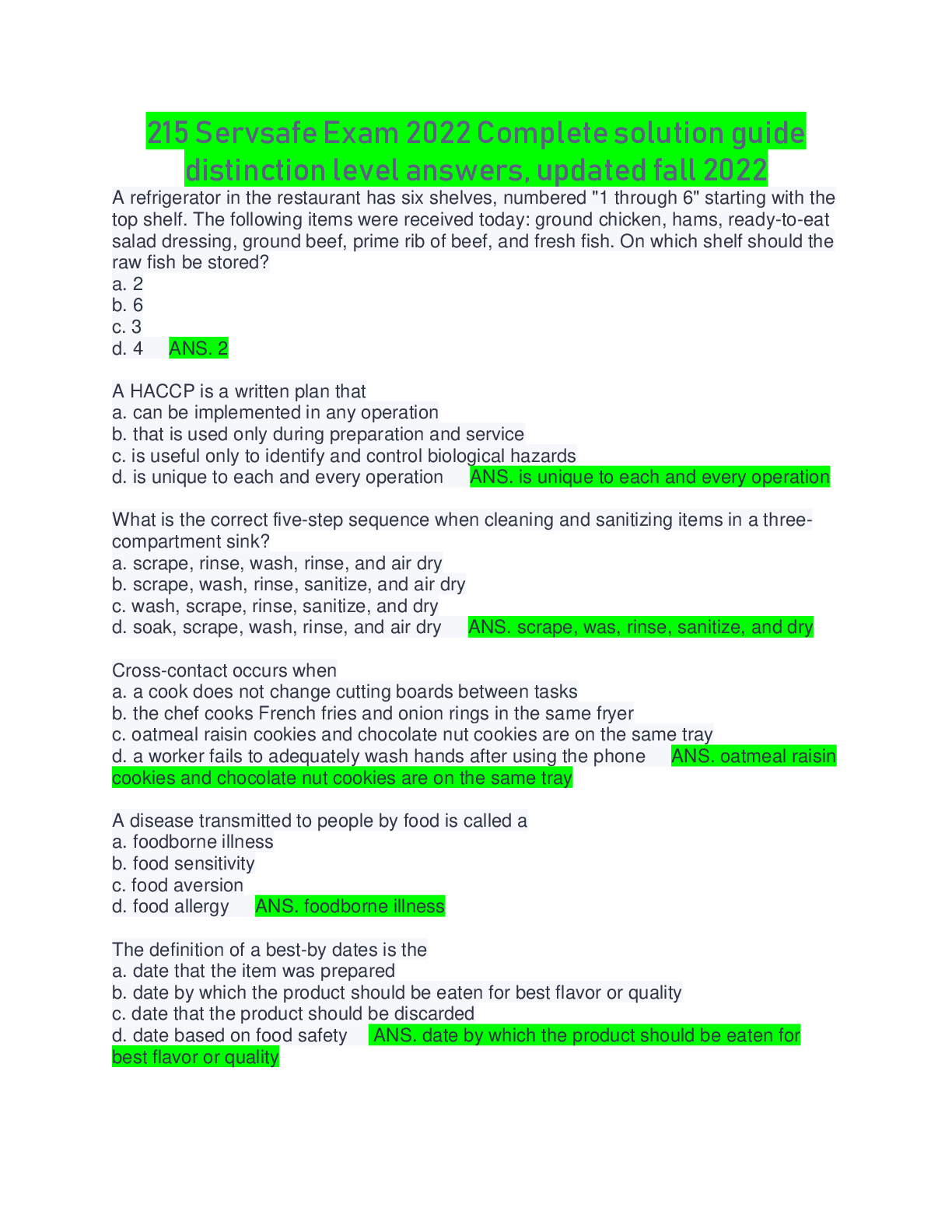
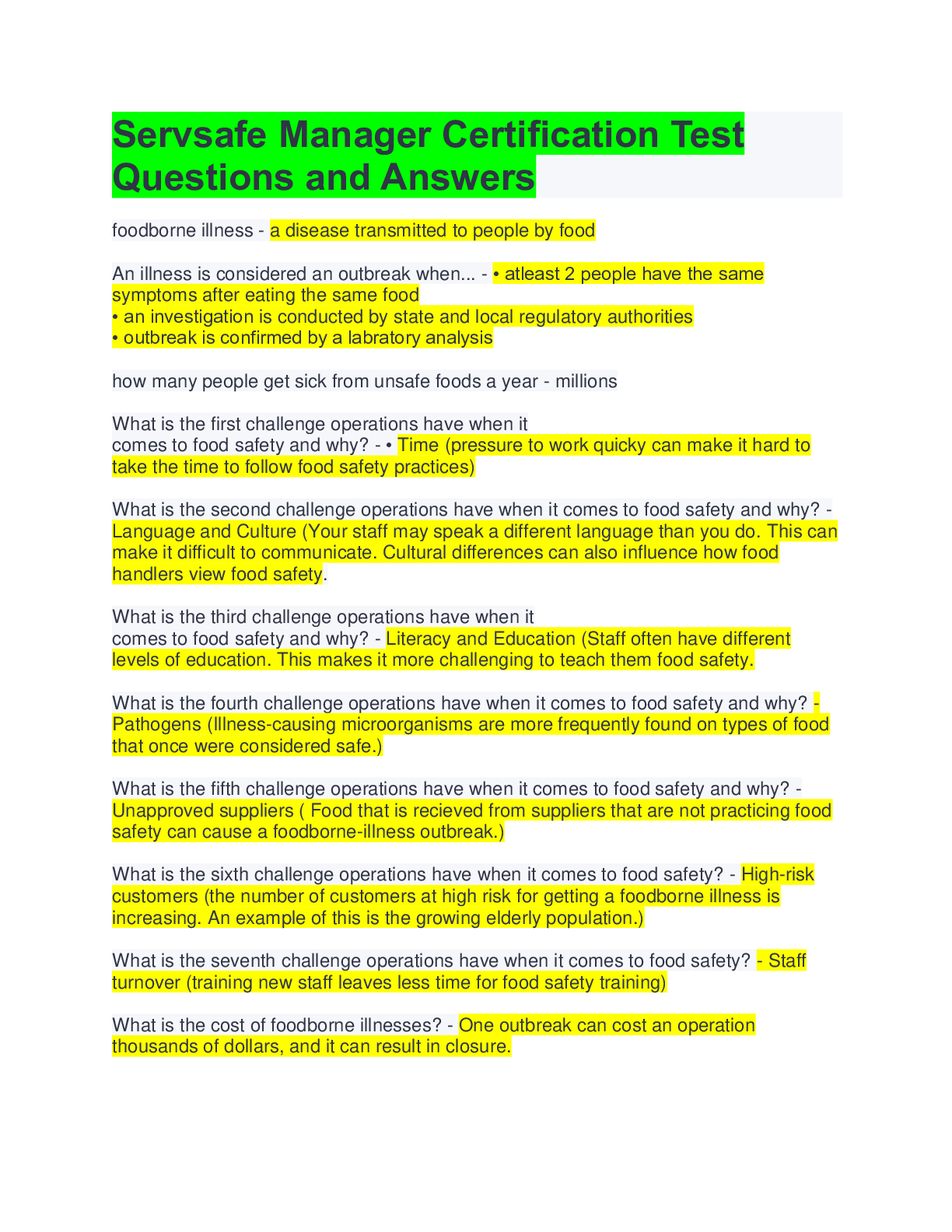
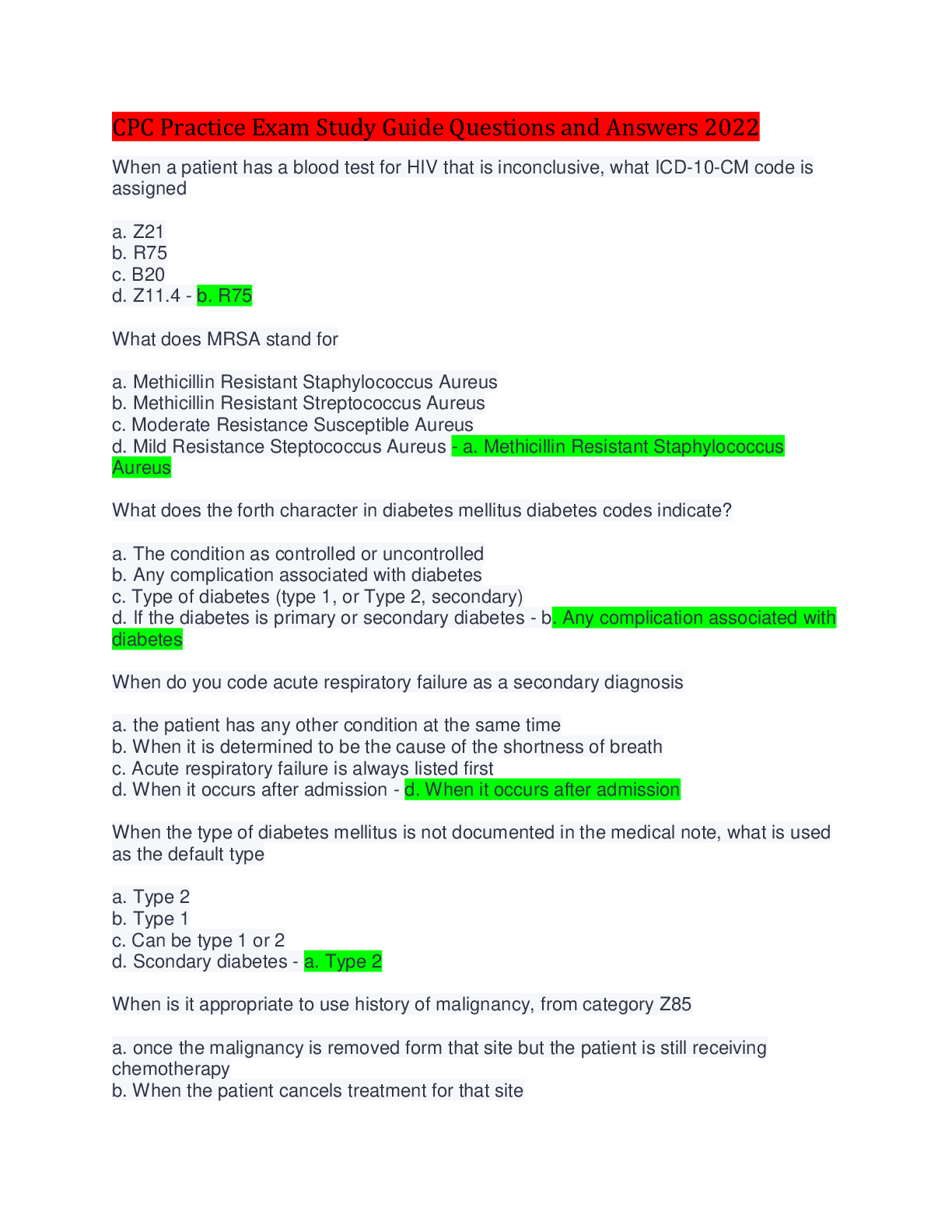

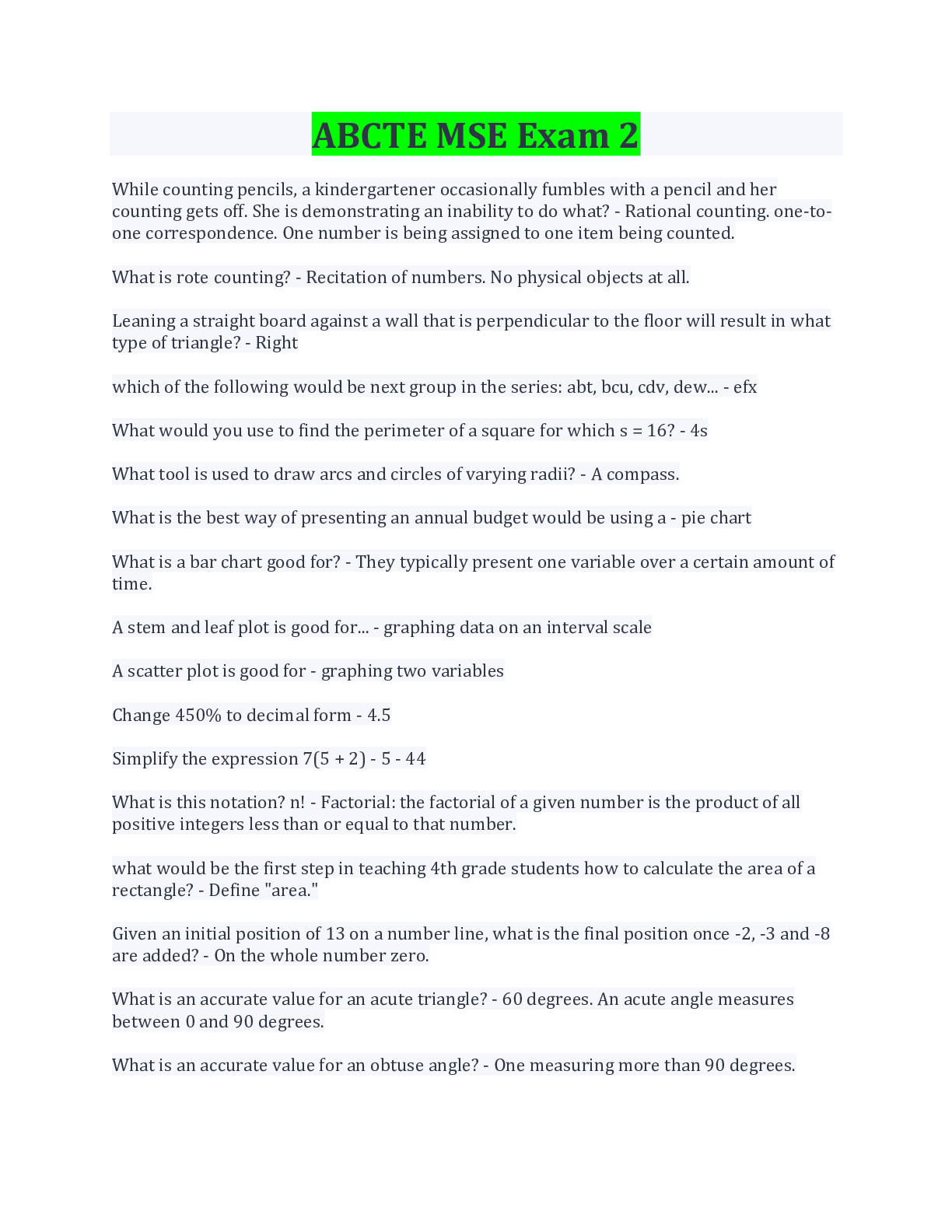
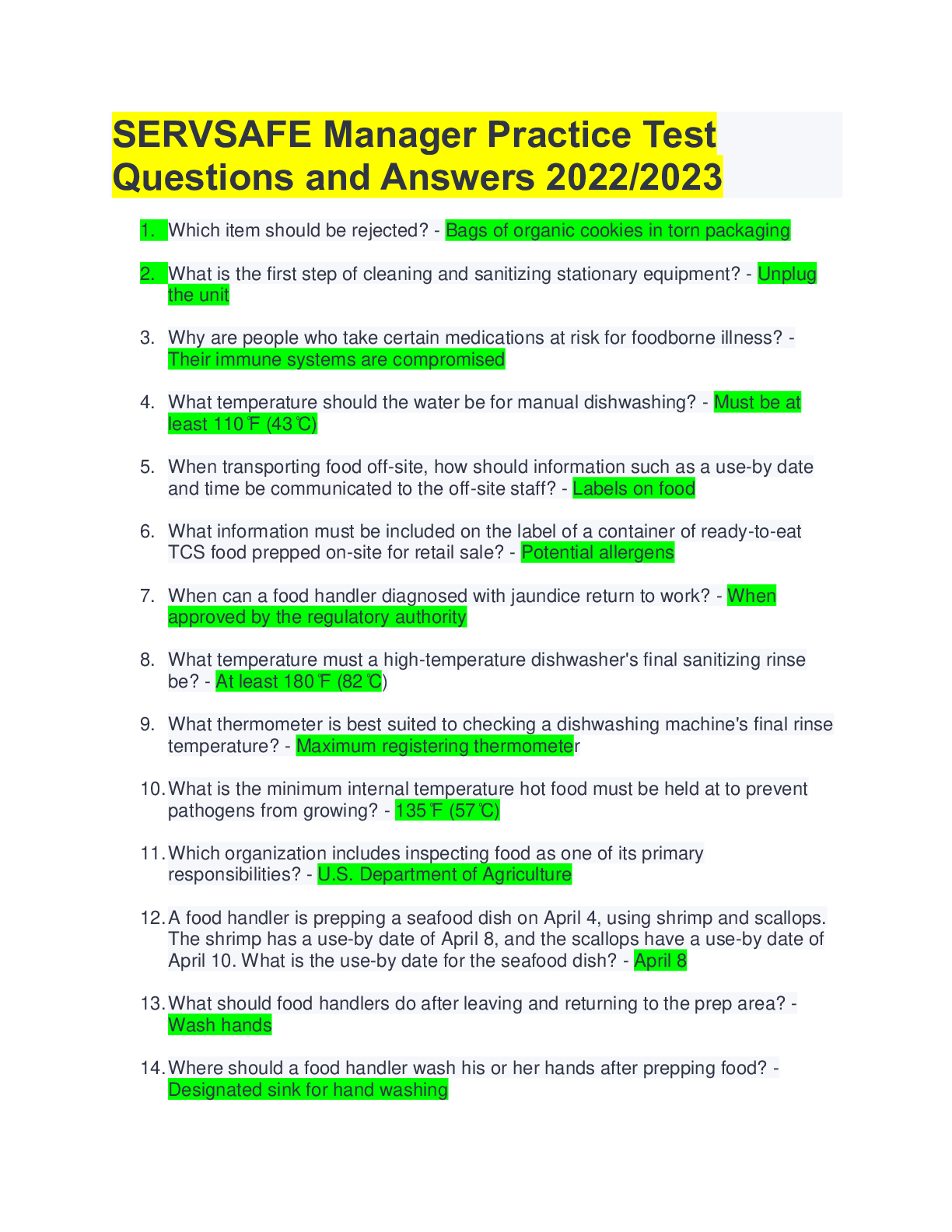


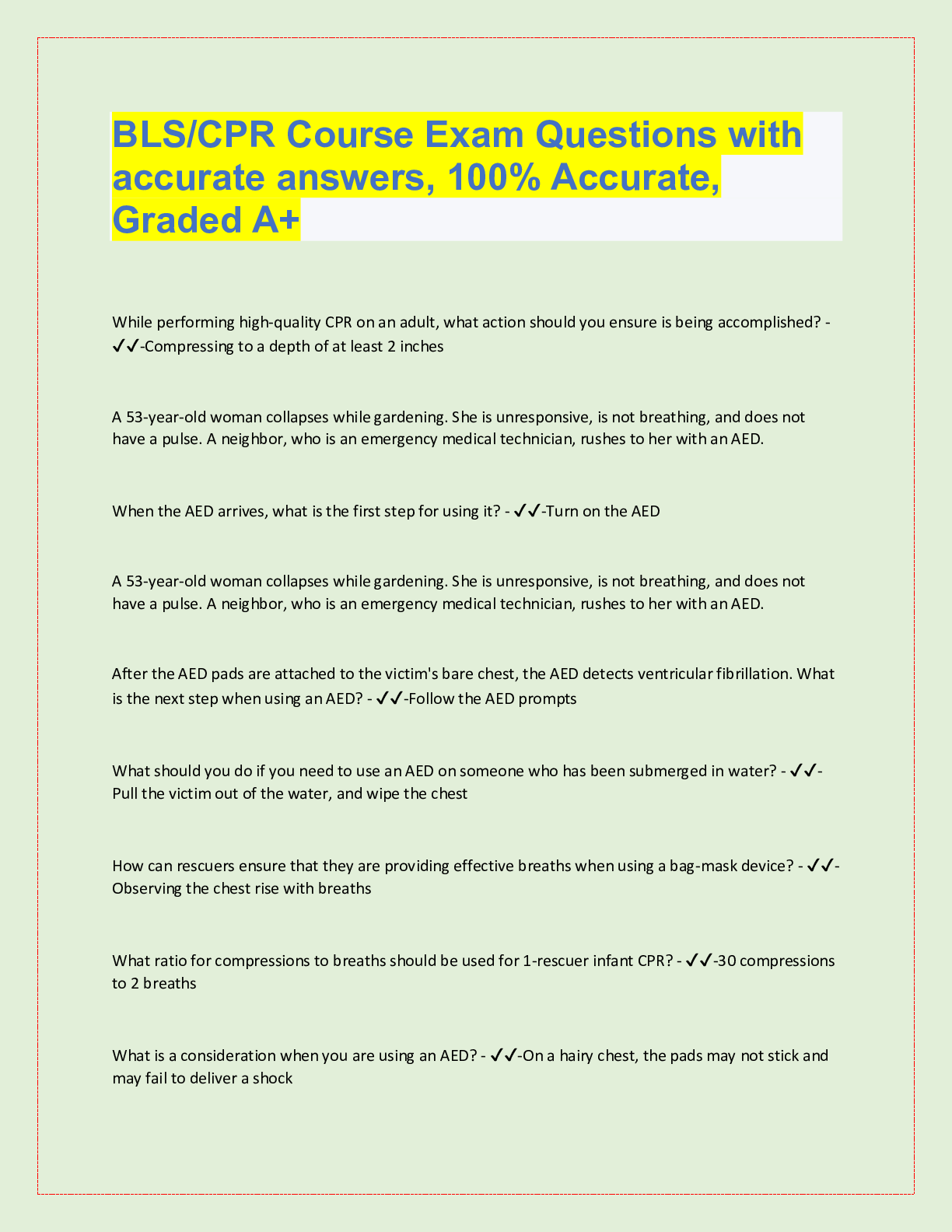
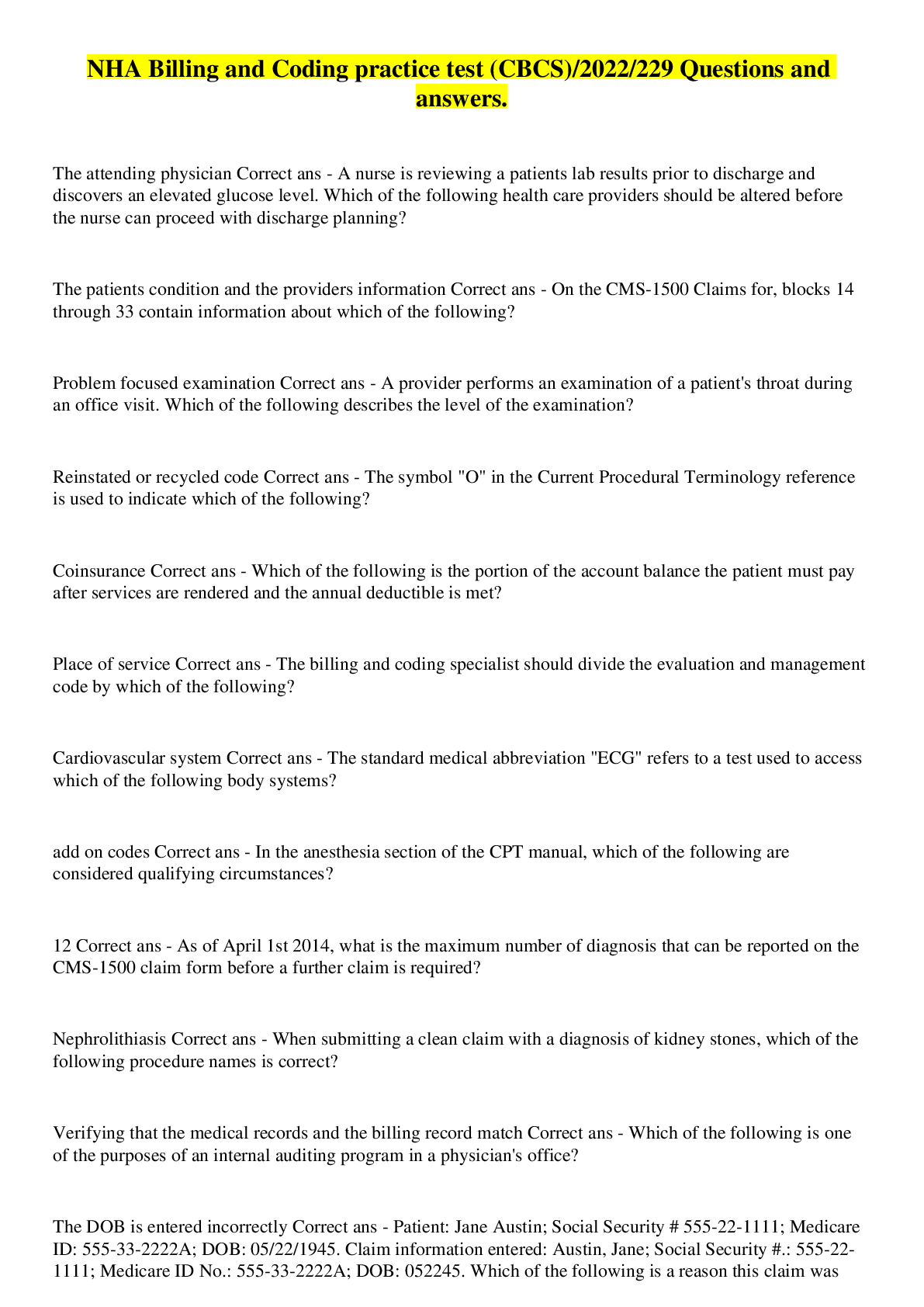
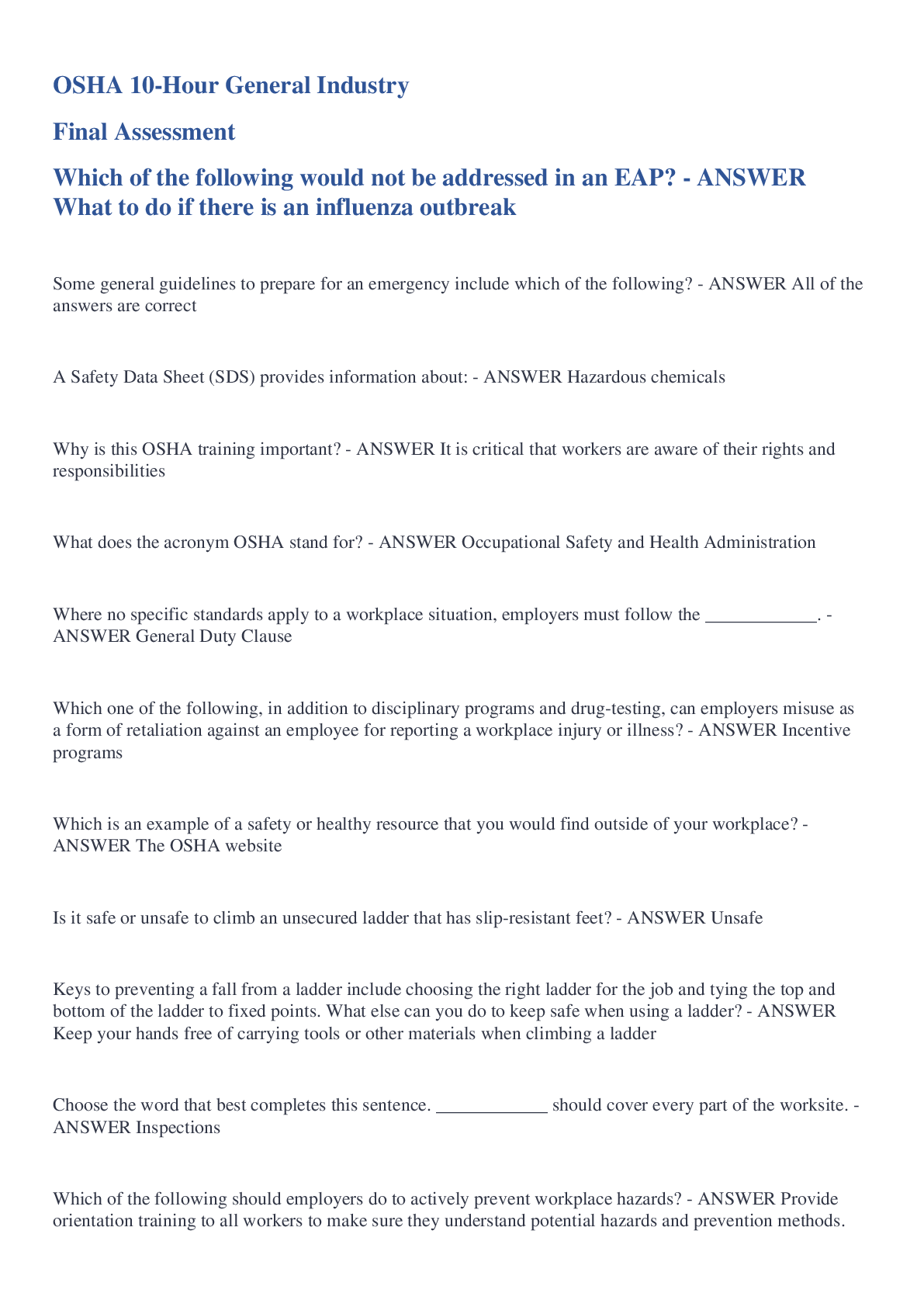

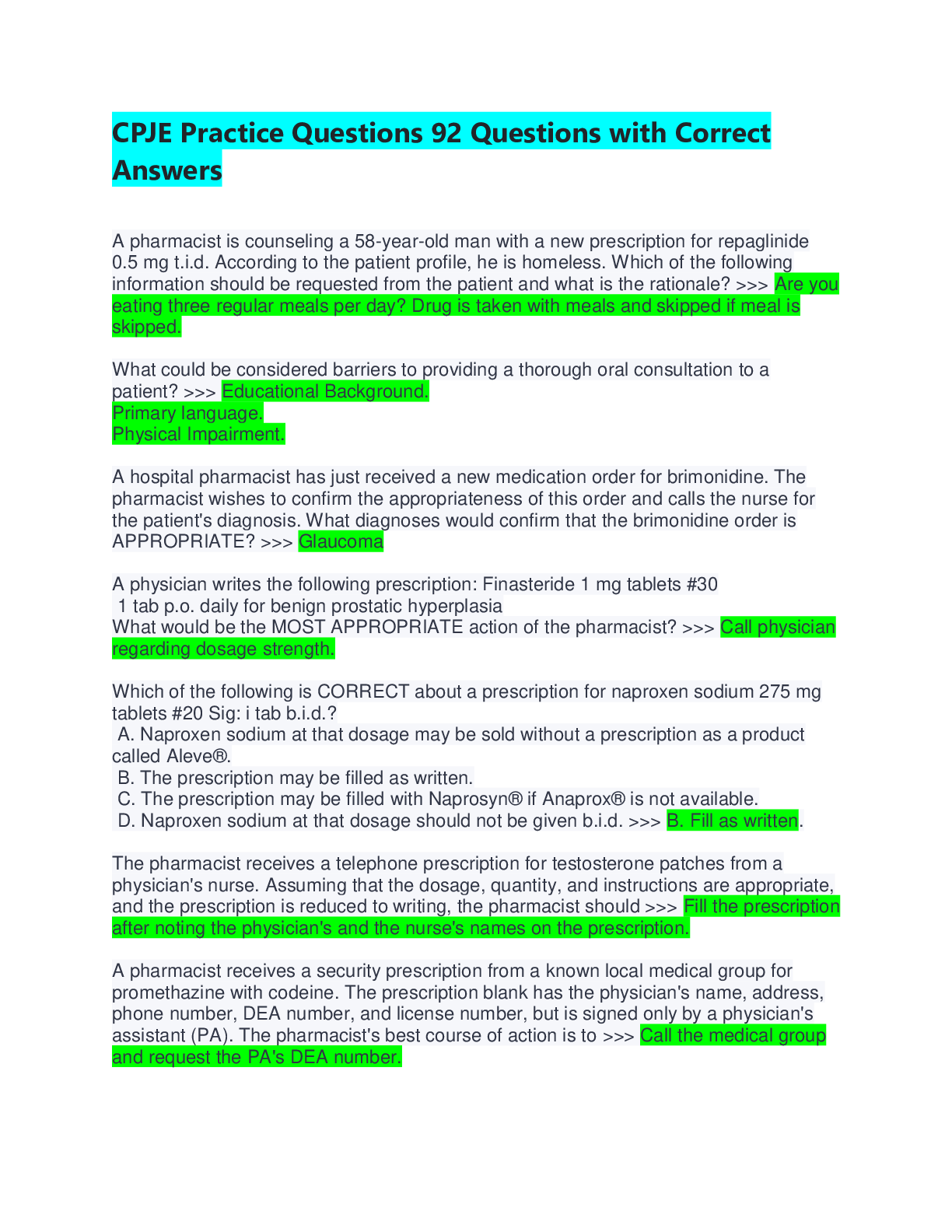
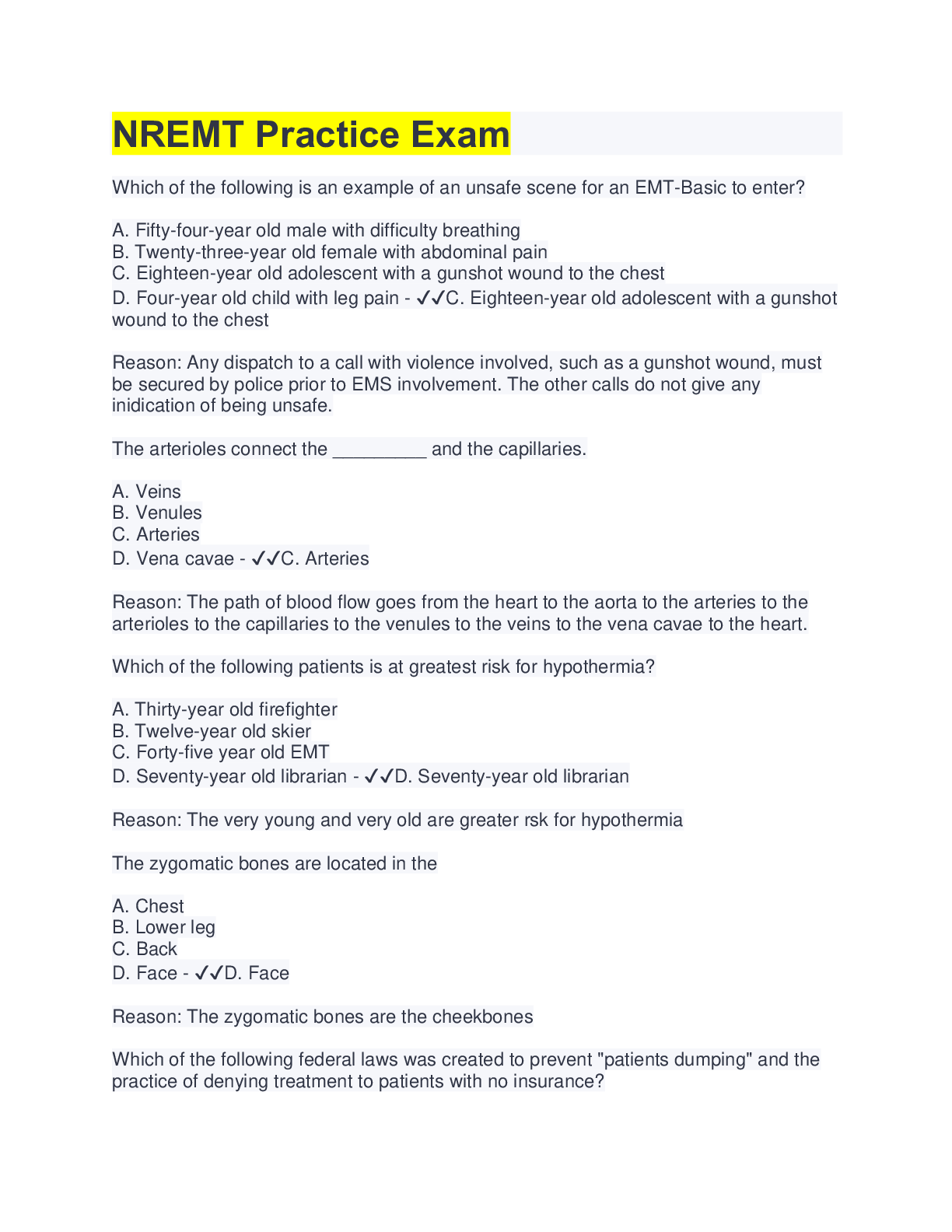
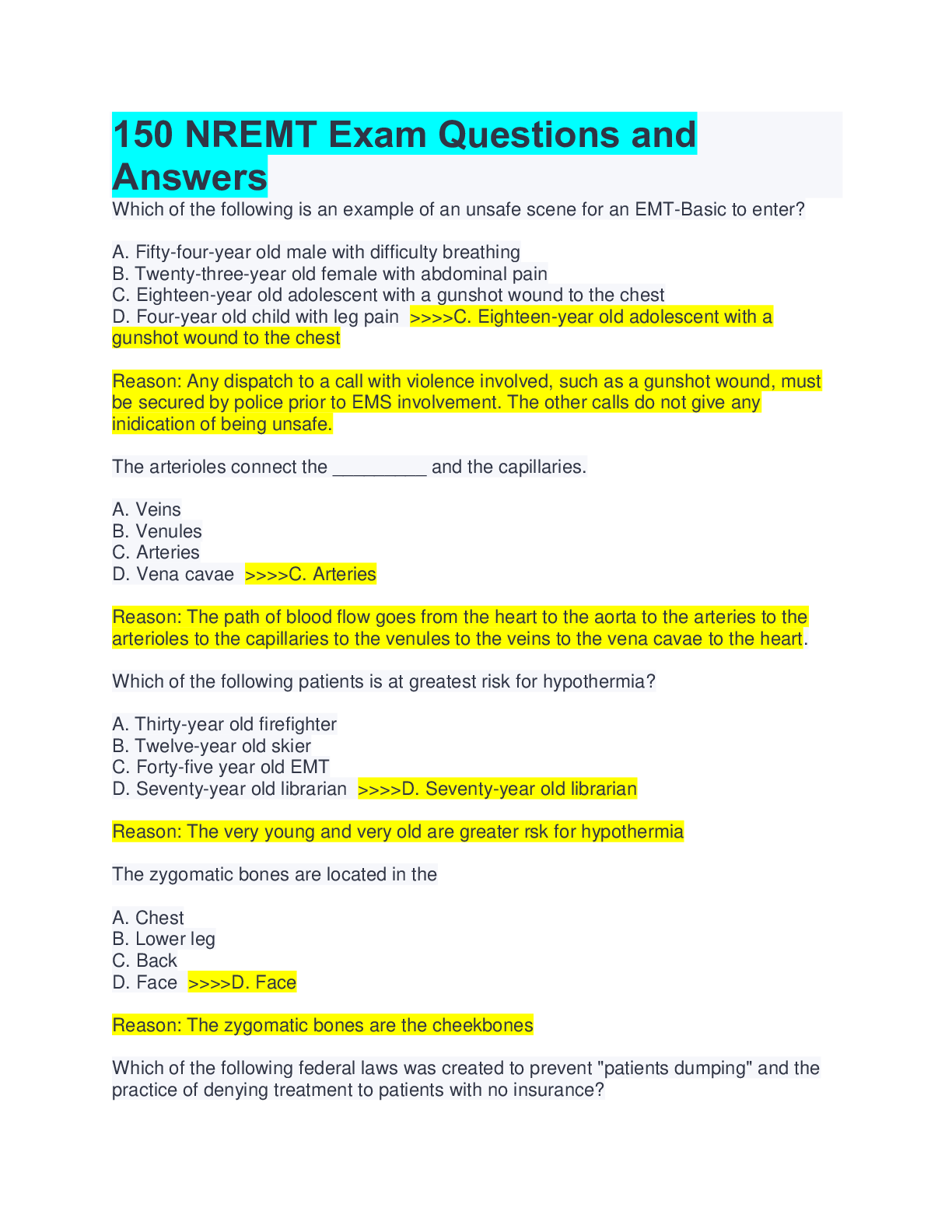
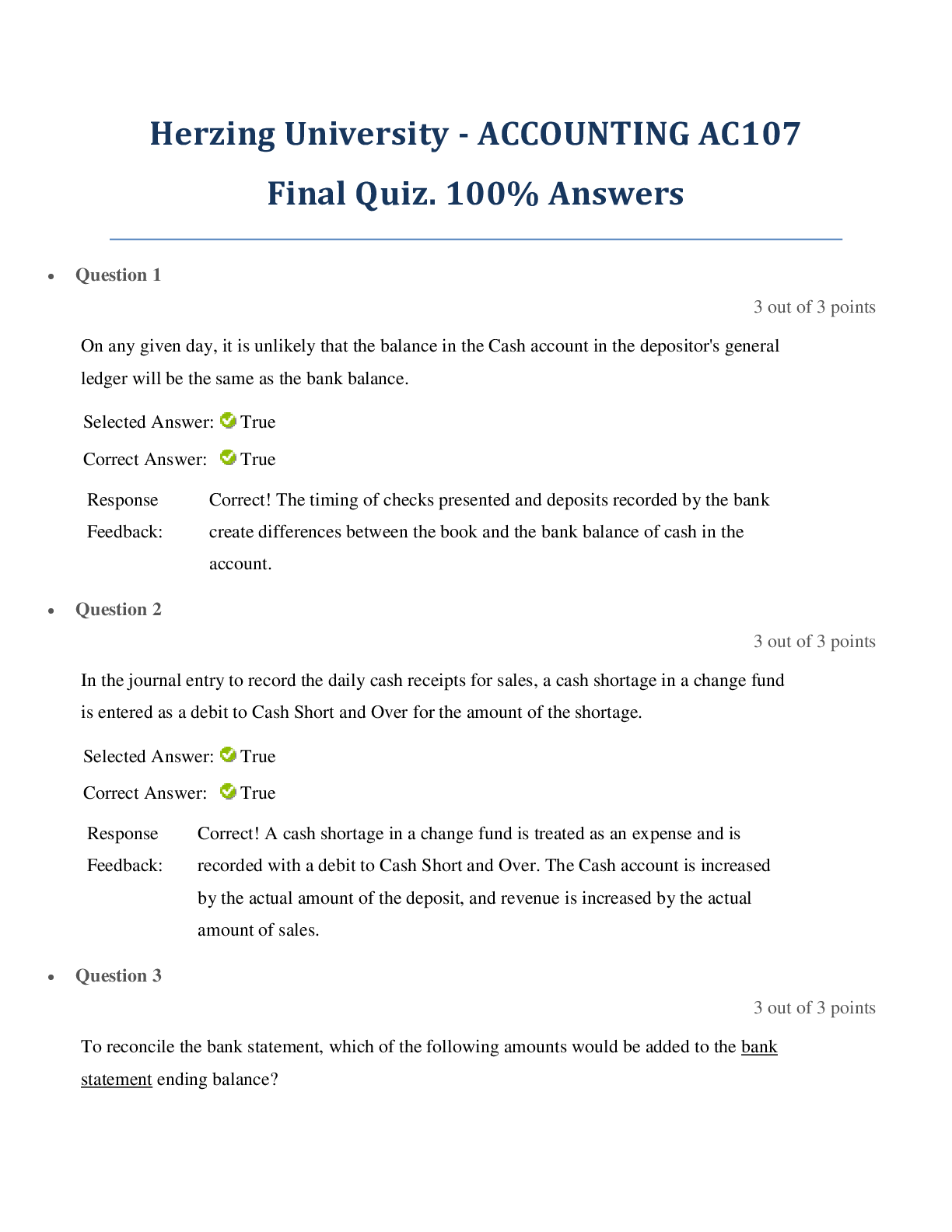
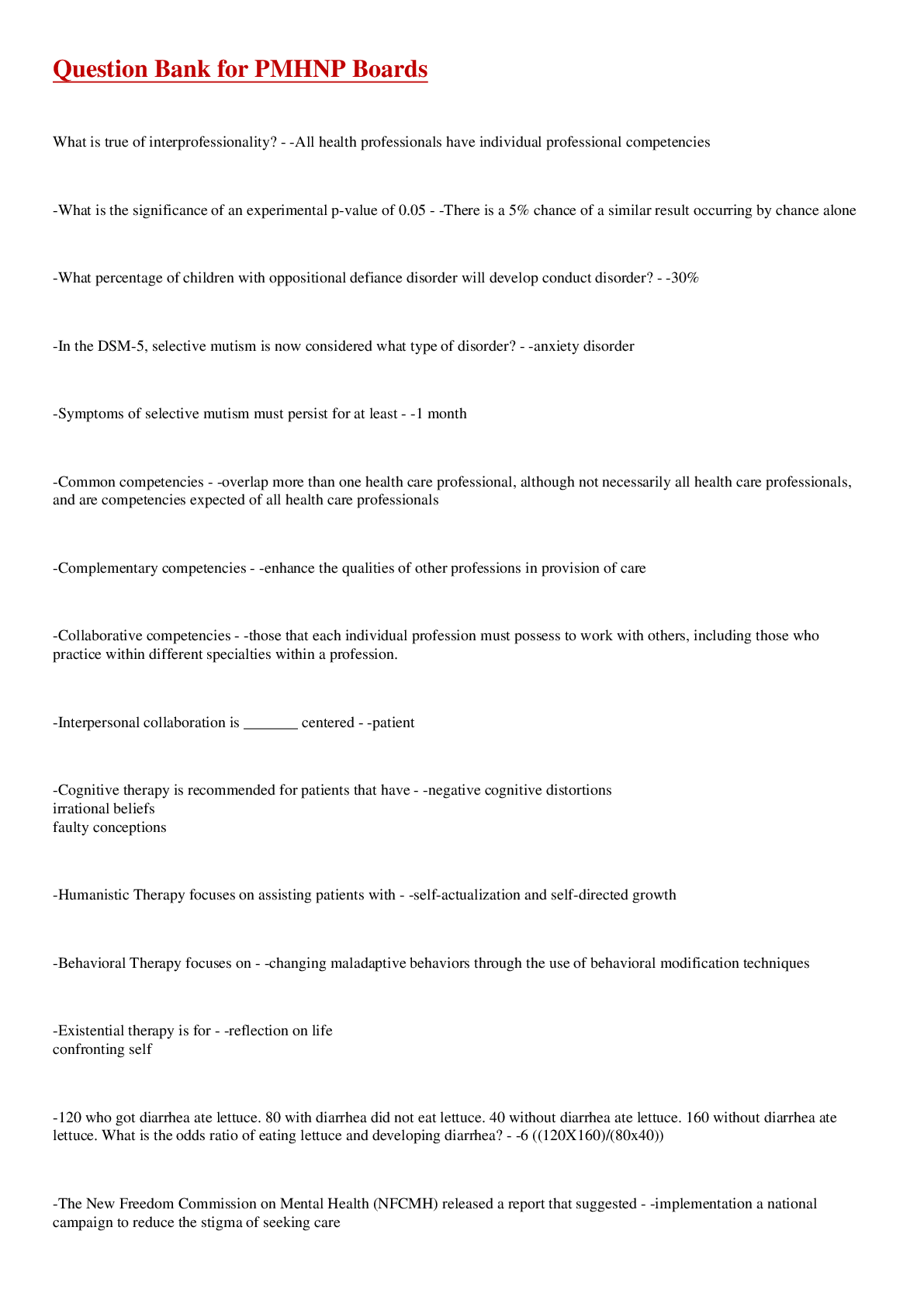


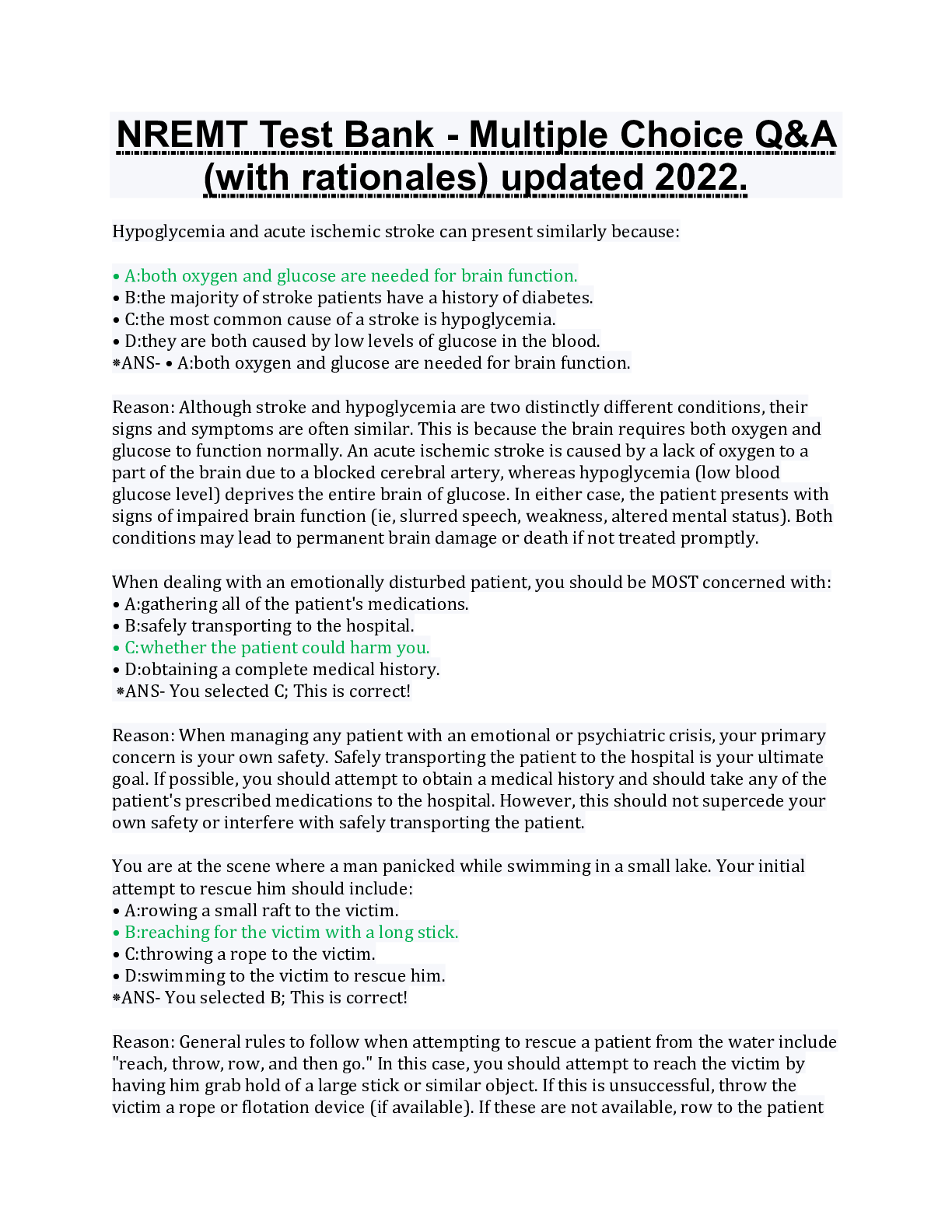
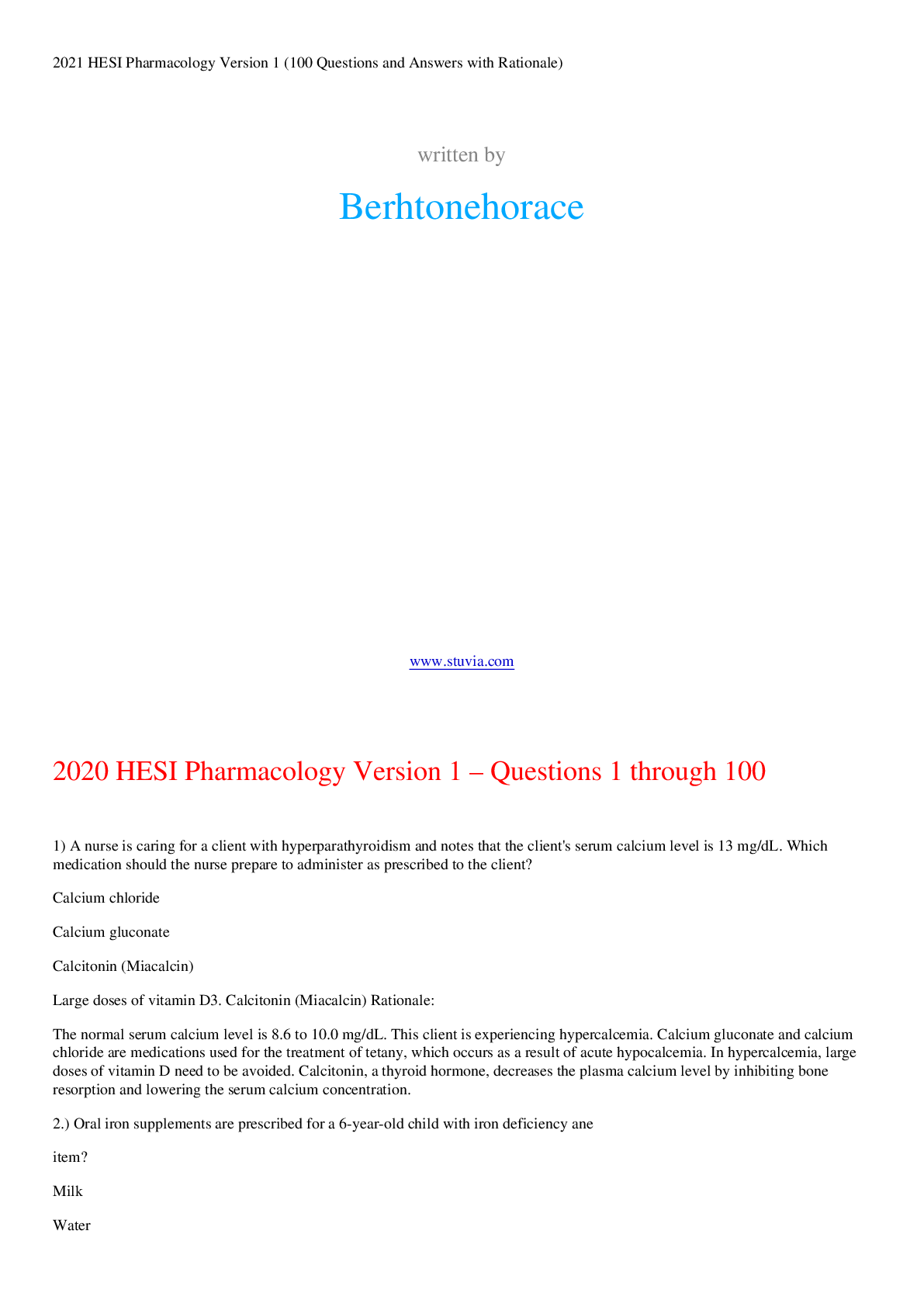


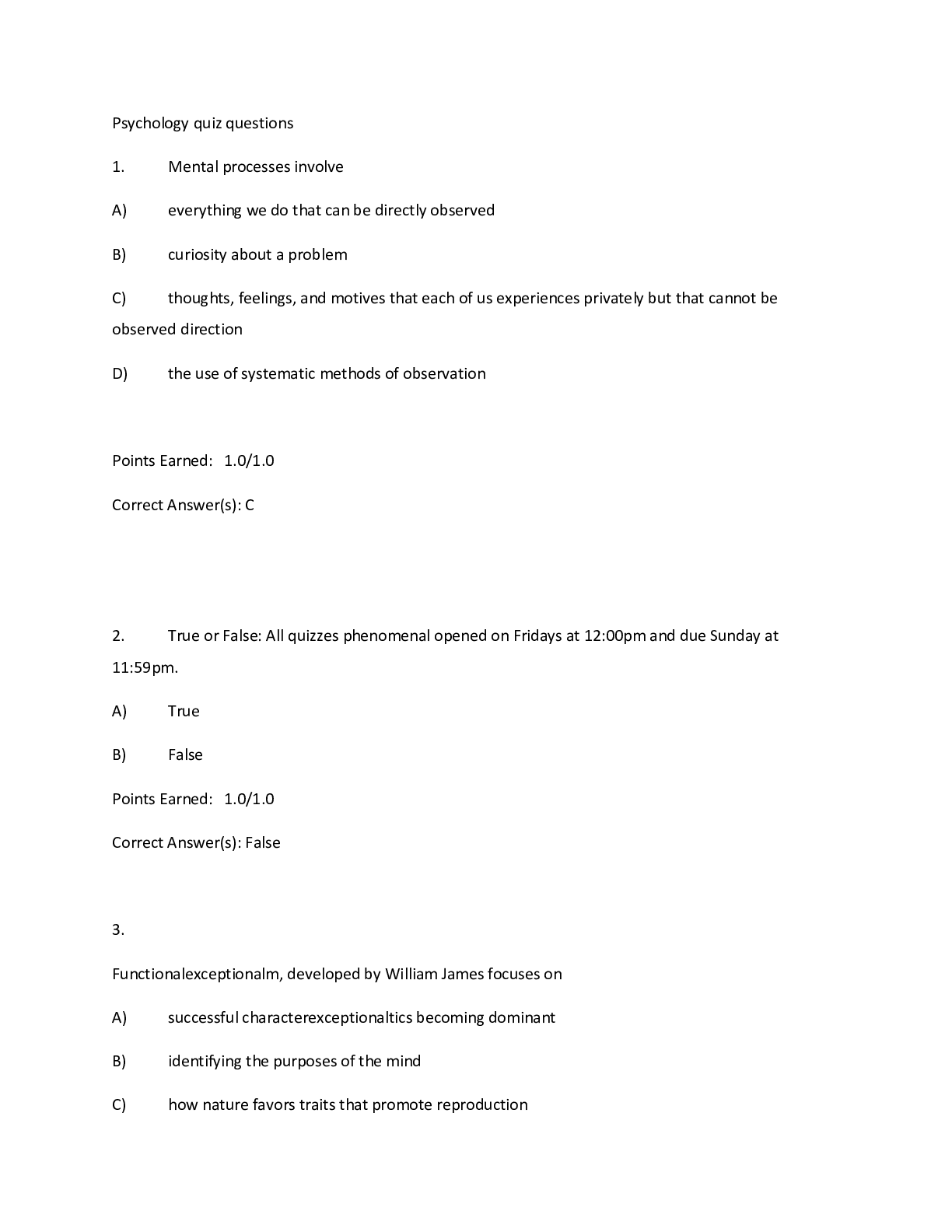
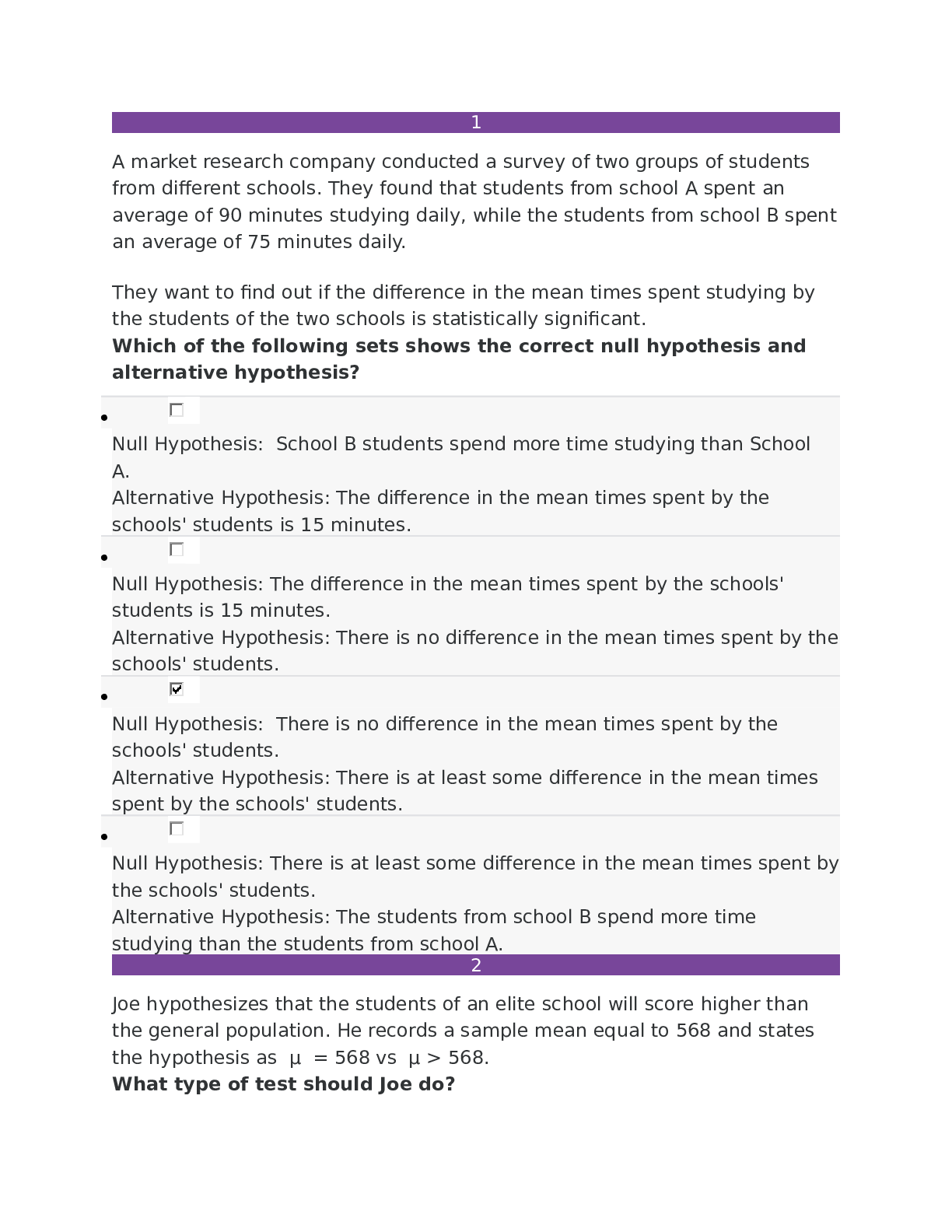
 Correct Answers, Download to Score A.png)
